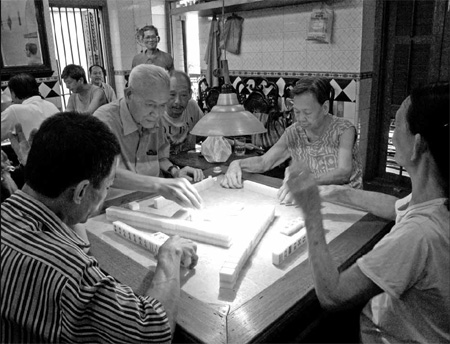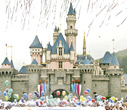Family
Home is where hearth is
By Chitralekha Basu (China Daily)
Updated: 2009-11-10 14:48
 |
|
Elderly Chinese gather to play mahjong in an unrestored colonial building in downtown Calcutta. |
In an iconic scene in the Satyajit Ray film Aparajito (The Unvanquished, 1956) when young protagonist Apu, newly-arrived in Calcutta from the village, stops under a shade in the rain, he has a multitude of faces - European, Indian and Chinese - standing around him.
That shade still stands in the Eastern Indian city of Calcutta's book district, in College Square.
But the Chinese, who first landed here in the 1750s and came to work at Calcutta Port, seem to have left. According to unofficial estimates, they numbered more than 150,000 in the 1950s in a city that was the cultural hotspot of a newly liberated India.
The "maze of alleys" darting out of Bentinck Street, bang in the heart of downtown Calcutta, "extending and touching Bowbazar and the area opposite the police headquarters at Lalbazar - Chhattawala Gali, Phears Lane and Blackburn Lane", is gone, reminisces Soumitra Das, demarcating the area that used to be old Chinatown.
Das, an authority on Calcutta's street history, grew up in the area, watching the gradual dwindling of the Chinese population from up close, since the Calcutta Improvement Trust demolished the old Chinatown, the only one of its kind in India, in the early 1960s.
The saddest part of it, says Das, was to see the leather goods shops along Bentinck Street run by the Chinese being closed down.
 |
|
The 120-year-old Chinese Buddhist shrine Nam Soon Church still stands in the area that used to be old Chinatown in Calcutta, India. |
Soon one would need a fine-toothed comb to locate Chinese faces in Poddar Court, the hub of old China Town, now turned into an impersonal assembly-line battery of office buildings, towering over the lone Chinese structure - the pagoda-roofed Sea Ip Church. Portraits of Mahatma Gandhi and Sun Yat Sen hang side by side on its high and sooty walls. Antique chairs with elaborate curlicues carved on the back are reminders of the Chinese connection.
Founded in 1905 by the Cantonese migrants to serve as a forum for the Chinese in India, the Sea Ip Church still serves as a welfare organization, sponsoring Qingming and mid-Autumn festivals, supporting people who are ailing or need legal help. A few white-haired men drop by every day to chat and read the only Chinese newspaper published from Calcutta, the Overseas Chinese Commerce of India. Says Wah Cheong, 83, who arrived in 1948 from Guangdong and found work as a carpenter, "Sure, I would like to go back and visit my hometown, but where is the money?"
Across the road, stashed away in an obscure corner of Blackburn Lane, is a courtyard house that doubles as a prayer hall and a school. Nam Soon Church, more than 120 years old, is like a typical shrine inside a Buddhist monastery where the deities Avalokiteswara and Padmasambhaba - different forms of the Buddha - look on with a benign gaze. Pint-sized children study next door, under the supervision of the diminutive Ho Shao Yen, who attended the same school in 1953, with other Chinese children.
Today she is the school principal, but the minuscule minority of Chinese children left in the city prefers to go to higher profile schools. Those who could afford it have migrated to Canada and Australia. "Earlier we would celebrate (China's) National Day on Oct 1. This time I just watched the parade at Tian'anmen on TV. There's very few people left here to celebrate with," Yen says, matter-of-factly.
Close by, next to the hole-in-a-wall De Ley restaurant, a dimly lit staircase leads to the second floor of an unrestored colonial building. Men and women sit around tables, under the glare of lamps with conical shades, lighting up stacks of plastic mahjong sets on the board, concentrating on the game with the assiduous attention of a yogi. Wins and losses are taken with an equal degree of stoicism.
Tangra, the other Chinese hub of Calcutta, not too far from the hotbed of real estate boom on either side of the Eastern Metropolitan Bypass, looks a picture of dereliction. A winding road forks out from the Park Circus connector, perpetually shuddering under heavy traffic, past the Grace Ling Liang School, to a patch that's desolate and almost tranquil, almost like a land that time forgot. The seat of Calcutta's biggest concentration of tanneries not-so-long-ago, Tangra today is known simply for its "authentic Chinese Indian cuisine" (Chinese dishes, doctored to suit the spice-favoring Indian palate).
Signboards, written in Chinese and English characters, dot the road. But the customers, whose number is dwindling, will arrive only later in the evening. One of the relatively big players in the restaurant business, Xie Yingxing, owner of Big Boss restaurant, is not unhappy that more than 80 percent of his customer base is now non-Chinese. The sixth-generation immigrant seems delighted to dish out the extra-spicy hot version of crab claws to his patrons.
KT Chang, who edits what is possibly India's only paper written in Chinese characters, out of a shabby two-room "clubhouse" where the lane seems to end, says his clientele is comprised entirely of old people who have interest in news of China. "Ninety-nine per cent of the young Chinese people have moved out anyway," he says, adding that the paper, founded in 1969, may stop publishing altogether, after he is gone.
Zhang Xing, an academic with Peking University who has researched the lives of the Chinese in Calcutta, worries that after the closing down of tanneries, the residences of the Hakka community who live in these areas might be pulled down as well.
Whether the land is claimed by realtors or the local government keeps its promise of turning the area into a gentrified Chinatown with tourist attractions, this winding stretch, with low-lying weedy tanks in between non-functional workshops, pickle factories and Chinese eateries, will not look the same again.







